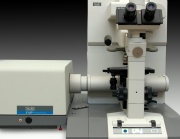Difference between revisions of "Fourier transform infrared spectroscopy"
| Line 2: | Line 2: | ||
== Description == | == Description == | ||
| − | + | An analysis technique used to obtain an absorption or emission spectrum of vibrational changes in chemical bonds. A Fourier-transform infrared (FTIR) spectrometer simultaneously collects high-resolution spectral data over a wide spectral range, typically 4000-600 cm-1 (wavenumbers). The vibrational changes that occur in chemical functional groups are unique and reproducible. The combination of these interactions with the infrared beam, represented as a spectrum, produce a unique pattern for each class of material. This confers a significant advantage over a dispersive spectrometer, which measures intensity over a narrow range of wavelengths at a time. in the components in a solid, liquid, or gas | |
== Synonyms and Related Terms == | == Synonyms and Related Terms == | ||
| Line 9: | Line 9: | ||
== Resources and Citations == | == Resources and Citations == | ||
| − | + | * Wikipedia: [https://en.wikipedia.org/wiki/Fourier-transform_infrared_spectroscopy Fourier-transform infrared spectroscopy] (Accessed June 2023) | |
| + | * National Gallery of Art Scientific Research: [https://www.nga.gov/conservation/glossary.html#spectroscopy Spectroscopy] | ||
* M.Derrick, D.Stulik, J.Landry, Infrared Spectroscopy in Conservation Science, In Scientific Tools for Conservation series, Getty Conservation Institute, Los Angeles, 1999. | * M.Derrick, D.Stulik, J.Landry, Infrared Spectroscopy in Conservation Science, In Scientific Tools for Conservation series, Getty Conservation Institute, Los Angeles, 1999. | ||
[[Category:Materials database]] | [[Category:Materials database]] | ||
Revision as of 14:23, 19 June 2023
Description
An analysis technique used to obtain an absorption or emission spectrum of vibrational changes in chemical bonds. A Fourier-transform infrared (FTIR) spectrometer simultaneously collects high-resolution spectral data over a wide spectral range, typically 4000-600 cm-1 (wavenumbers). The vibrational changes that occur in chemical functional groups are unique and reproducible. The combination of these interactions with the infrared beam, represented as a spectrum, produce a unique pattern for each class of material. This confers a significant advantage over a dispersive spectrometer, which measures intensity over a narrow range of wavelengths at a time. in the components in a solid, liquid, or gas
Synonyms and Related Terms
FT-IR; FTIR; fourier-transform infrared spectroscopy; Fourier-Transformation Infrarot Spektroskopie (Deut.); spectroscopie infrarouge par transformée de Fourier (Fr.);
Resources and Citations
- Wikipedia: Fourier-transform infrared spectroscopy (Accessed June 2023)
- National Gallery of Art Scientific Research: Spectroscopy
- M.Derrick, D.Stulik, J.Landry, Infrared Spectroscopy in Conservation Science, In Scientific Tools for Conservation series, Getty Conservation Institute, Los Angeles, 1999.
